Why Early Intervention Is Critical for Blind Children
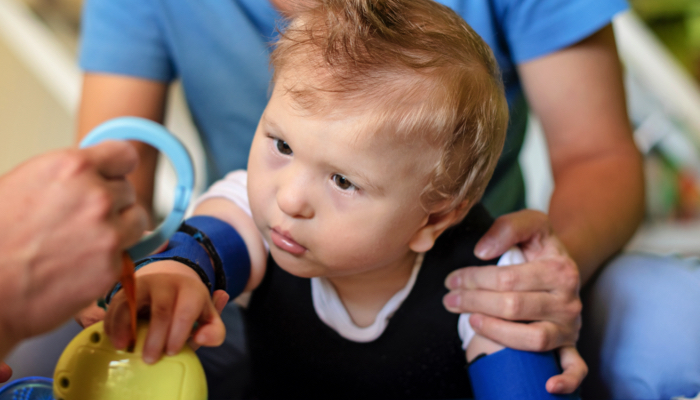
- The early years of a child’s life are crucial for development, making early intervention for children with vision loss imperative.
- Early intervention programs offer personalized support.
- Services offered in early intervention programs can play a transformative role in your visually impaired child’s life by laying a solid foundation for future learning and development.
Every parent dreams of giving their child the best start in life, but when your little one has a disability, this can seem more challenging.
Visual impairment can have an immediate impact on your child’s motor, language, emotional, social, and cognitive development. It could also cause family stress due to time involvement and finances.
According to the CDC11. Fast Facts About Vision Loss. Centers for Disease Control and Prevention. 2023. https://www.cdc.gov/visionhealth/basics/ced/fastfacts.htm#:~:text=Fast%20Facts%20About%20Vision%20Loss,-Fast%20Facts%20About&text=Approximately%206.8%25%20of%20children%20younger,wearing%20glasses%20or%20contact%20lenses., visual impairment or blindness affects approximately 3% of children under 18. If you believe your child has a visual disability, you’re not alone.
Getting a diagnosis may feel scary, but early intervention can be your child’s lifeline.
Early intervention for blind children ensures a strong foundation for future learning. These programs will help you understand your child’s unique needs and create a world of possibilities despite their disability.
Understanding Early Intervention for Blind Children
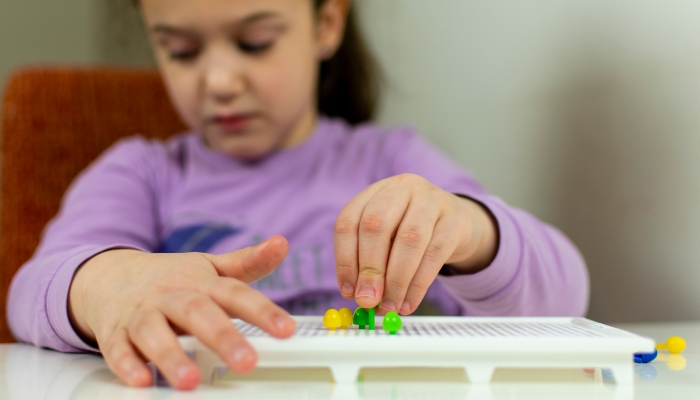
Early intervention for blind children is mandatory. The many intervention programs and services available are designed to assist blind children with communication, mobility, social development, and cognitive skills.
Programs focus on personalized support to meet the unique needs of your young child.
The early years of your little one’s life are a critical period for development. If your child has low vision or is blind, early intervention can play a transformative role.
The 2021 study Early Visual Training and Environmental Adaption for Infants with Visual Impairments22. Fazzi, E., Micheletti, S., Calza, S., Merabet, L., Rossi, A., & Galli, J.. Early visual training and environmental adaptation for infants with visual impairment. Developmental Medicine & Child Neurology. 2021;63(10), 1180–1193. https://doi.org/10.1111/dmcn.14865 recorded great visual function and neurological development improvement with early intervention in infants aged 4–11 months with visual impairment.
While several studies also show positive results in older children, early intervention for toddlers remain the best course of action.
Research and expert opinions suggest that the ideal time for initiating early intervention is soon after diagnosing or recognizing visual impairments.
Early intervention services are also not limited to your child.
You’re involved in the learning process since you play an integral role in your child’s life. Home visits, guidance from teachers and specialists, and participation in support groups are part of the process.
Early intervention acknowledges the importance of early childhood in shaping a child’s future. It also advocates for timely assessment and continuous support.
Through these programs, your visually impaired child will be better prepared to face the world, making the most of their abilities and thriving despite their challenges.
Early Intervention Services for Visually Impaired Children

Every child with visual impairments has different needs. Early intervention services recognize this and are multifaceted to address the growth and independence your little one requires.
Here is a brief overview of early intervention services available:
Language and speech therapy: This targeted intervention will support your child’s communication skills, which are crucial for social and educational development.
Specialized education: These programs focus on the unique learning needs of visually impaired children. They can teach your child braille, how to use assistive technology, and adaptive skills for daily living.
Access to assistive technology: This subprogram of education will introduce your child to assistive technologies like screen readers, magnification devices, and braille note-takers to enhance their learning and independence.
Occupational therapy: Focused on improving fine motor skills and daily living activities, this program will help your child perform everyday tasks independently.
Orientation and mobility training: Spatial awareness programs help your little one develop safe navigation skills in different environments, both indoor and outdoor.
Family education and support: These programs are designed to educate and support you so you understand your child’s needs and how to best support their development.
Early Intervention Program Components
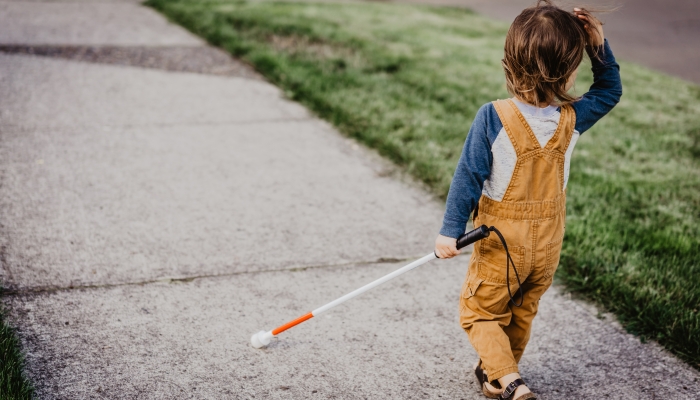
Early intervention programs aim to address your child’s immediate developmental needs and lay a strong foundation for their future growth and success. That’s why each service embodies the following components:
- Individualized education plans (IEPs)
- Multidisciplinary teams
- Regular assessments
- Transition services
- Parental and family involvement
- Community integration
Regardless of the early intervention program implemented, your child will receive a customized education plan that addresses their specific educational need, goals, and learning style. A collaborative approach from educators, therapists, specialists in visual impairments, and you will ensure that the support your little one receives covers all aspects of their development.
Ongoing evaluations take place to monitor each child’s progress and adjust their intervention strategies as needed. These evaluations will assess your child’s academic achievements, social-emotional development, and functional vision.
As your child grows, services adapt to ensure they transition smoothly to the next stage of their life.
Most early intervention programs heavily rely on parental or caregiver involvement. You’ll be equipped with training and resources for at-home use and encouraged to participate in community activities.
A supportive network is the backbone of these programs and improves its success.
Why Is Early Intervention Important for Blind Children?

Visual processing disorders, low vision, and blindness can affect your child’s overall development and quality of life as well as family finances and relationships. Early intervention programs play a crucial part in minimizing any challenges.
Children in early intervention programs learn critical skills that compensate for the lack of visual input. This includes developing heightened auditory senses, enhanced verbal and non-verbal communication, and skills like self-care, navigation, and the use of assistive technology that fosters independence and confidence.
Early intervention helps children develop a positive self-image and resilience. Children learn to express themselves, understand their emotions, and cope with the challenges of blindness.
These programs are not just an educational necessity. It helps visually impaired infants get the best start in life with long-lasting benefits.
Published in 2002, The Impact of Early Intervention on a Child with Vision Loss in Infancy – A Parental Perspective33. Veer, A., Kulkarni, S., Gaikwad, A., & Deshpande, M.. The impact of early intervention on a child with vision loss in infancy – A parental perspective. Indian Journal of Ophthalmology. 2022;70(9), 3377–3381. https://doi.org/10.4103/ijo.ijo_412_22 recorded a positive change in the behavior and development of children with visual impairments alongside improved family dynamics after implementing early interventions.
Studies like this support the need for early intervention programs and showcase the significant social, emotional, and cognitive benefits these services can have for your child.
How to Find an Early Intervention Program for Your Child
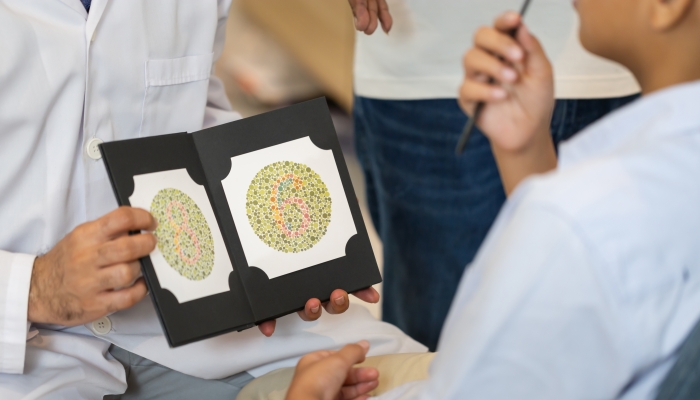
Finding the right early intervention center for your visually impaired child can make all the difference. Children thrive when they receive the support and services their unique challenges require.
Understanding the eligibility criteria and the steps to access these programs will make the process smoother.
While each program has different eligibility criteria, early intervention services typically depend on these factors:
Age requirements: Early intervention programs are generally designed for children from birth to three years.
Diagnosis and assessment: A comprehensive and formal diagnosis of visual impairment or blindness by an ophthalmologist or developmental pediatrician is required. These assessments usually include evaluations of your child’s vision, cognitive abilities, and overall development.
Developmental delays: Some programs are designed to address specific developmental delays, regardless of the specific diagnosis. If you suspect your child has visual impairments, visiting their pediatrician should be your first step. They can provide an initial assessment and refer you to specialists for a more in-depth diagnosis.
Once visual impairment has been confirmed, you can:
- Ask for referrals from your child’s healthcare provider.
- Contact your local health departments to inform you of the appropriate early intervention services available.
- Contact local and national organizations for the blind for resources and information.
- Explore online options, like websites or support groups with directories of services and programs.
- Find and connect with other families who have visually impaired children who can provide practical advice and emotional support.
If available, visit different early intervention centers or programs to find the best fit for your child’s needs. You should remember to stay informed about any developments about available services.
Early Intervention Empowers Visually Impaired Children
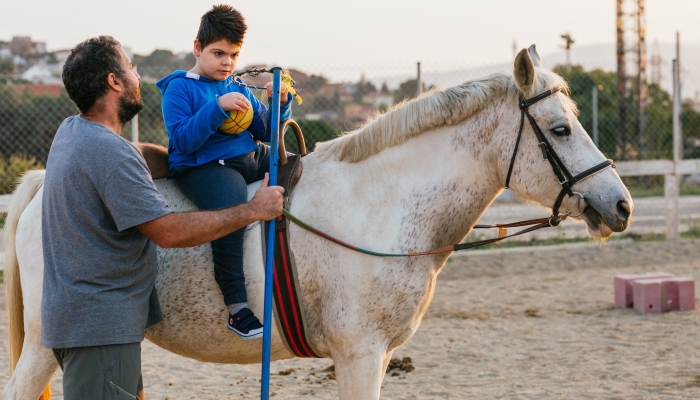
Early intervention can help your visually impaired child reach developmental milestones and become more resilient. The collaborative approach of these programs ensures individualized plans so your little one can thrive to the best of their abilities.
Children who partake in early intervention programs get the head start they deserve. From numerous studies, it’s clear that the services offered in these programs create positive outcomes.
Early intervention programs will unfold your child’s potential so they can make the most of their abilities and thrive despite challenges. By intervening early, you can set your visually impaired child up to live an independent life with confidence.
FAQs
What are some limitations of early intervention programs?
The success of early intervention programs relies heavily on parental or caregiver engagement. Work commitments or a lack of awareness often limit the support visually impaired children receive, ultimately limiting the program’s effectiveness.
Limited resources, especially in terms of specialized educators and assistive technologies, also often pose challenges for organizations wanting to offer early intervention programs.
Other limiting factors affecting families in remote areas or those facing financial troubles are geographical constraints and financial obligations.
How can I advocate for my blind child within the early intervention system?
Advocating for your child within the early intervention system will ensure they get the best possible support. To do this, you should start familiarizing yourself with your child’s rights under the Individuals with Disabilities Education Act (IDEA)44. Individuals with Disabilities Education Act (IDEA). U.S. Department of Education. https://sites.ed.gov/idea and understand which specific services they are entitled to.
Actively participating in meetings, communicating openly, and staying informed about available resources, support groups, and educational materials will also empower you to secure the best outcome for your child’s needs.
If needed, you can seek guidance from advocacy organizations that specialize in supporting primary caregivers of visually impaired children.
What resources are available to me as a parent of a blind child in an early intervention program?
Available resources will differ between early intervention programs, but a wealth of information is provided online by organizations like the National Organization of Parents of Blind Children55. Welcome to the National Organization of Parents of Blind Children. National Federation of the Blind. https://nopbc.org, the American Council of the Blind66. Fostering Voice, Choice, and Community. American Council of the Blind. https://www.acb.org, and the American Foundation for the Blind77. Home. The American Foundation for the Blind. https://www.afb.org.
Tapping into these resources while also joining support groups and connecting with other parents who share similar experiences will help you collect invaluable information, practical advice, and emotional support.
References
- Fast Facts About Vision Loss. Centers for Disease Control and Prevention. (2023, August 15). https://www.cdc.gov/visionhealth/basics/ced/fastfacts.htm#:~:text=Fast%20Facts%20About%20Vision%20Loss,-Fast%20Facts%20About&text=Approximately%206.8%25%20of%20children%20younger,wearing%20glasses%20or%20contact%20lenses.
- Fazzi, E., Micheletti, S., Calza, S., Merabet, L., Rossi, A., & Galli, J. (2021). Early visual training and environmental adaptation for infants with visual impairment. Developmental Medicine & Child Neurology, 63(10), 1180–1193. https://doi.org/10.1111/dmcn.14865
- Veer, A., Kulkarni, S., Gaikwad, A., & Deshpande, M. (2022). The impact of early intervention on a child with vision loss in infancy – A parental perspective. Indian Journal of Ophthalmology, 70(9), 3377–3381. https://doi.org/10.4103/ijo.ijo_412_22
- Individuals with Disabilities Education Act (IDEA). U.S. Department of Education. (n.d.). https://sites.ed.gov/idea
- Welcome to the National Organization of Parents of Blind Children. National Federation of the Blind. (n.d.). https://nopbc.org
- Fostering Voice, Choice, and Community. American Council of the Blind. (n.d.). https://www.acb.org
- Home. The American Foundation for the Blind. (n.d.). https://www.afb.org
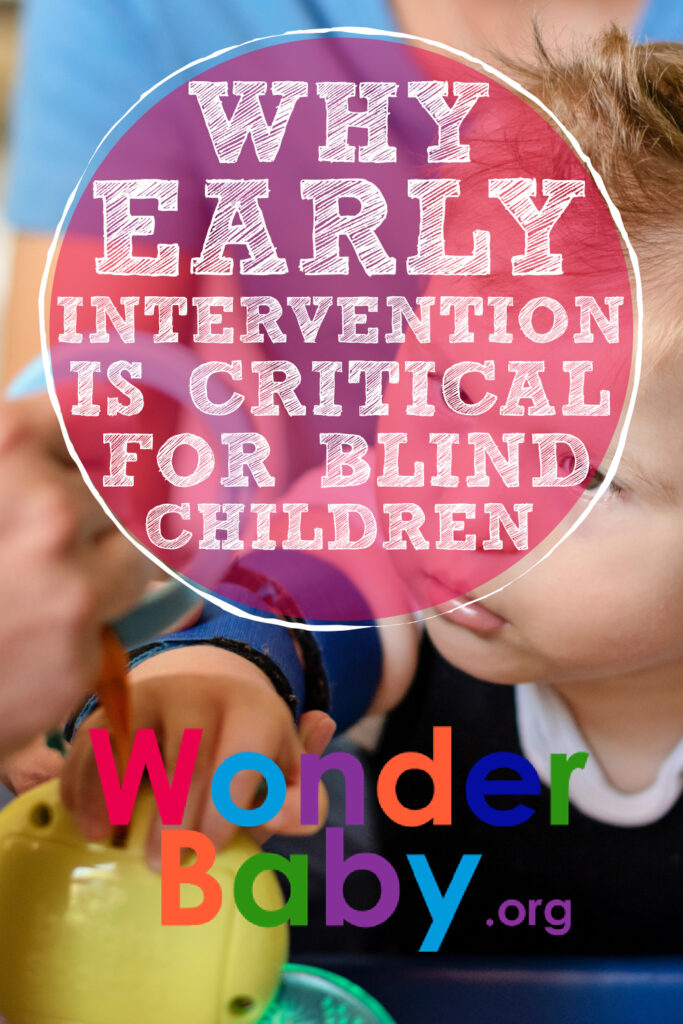
Related Posts

Eye Conditions and Syndromes, Visual Impairment
Neuralink Announces Plans to Restore Sight to the Blind with Brain Chip
Elon Musk’s company Neuralink has announced plans to begin human trials of its new “Blindsight” brain chip by the end of 2025.

Special Needs
5 Spring Cleaning Tips for Families of Children with Disabilities
Spring cleaning is an opportunity to create a more accessible, organized, and supportive space for your child with disabilities. Declutter, deep clean, and refresh!

Visual Impairment
The Gift of Understanding: How a Young Child Helps His Blind Father Navigate Life
When a parent is blind, it’s natural for people to wonder how their sighted child will adapt. Will they struggle to understand their parent’s needs? Will they feel burdened by...